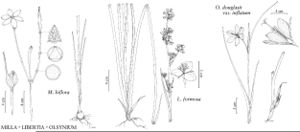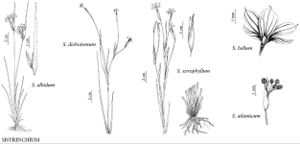Herbs, perennial, rarely annual [or shrubs with woody caudex], evergreen or seasonal, sometimes cespitose; rootstock a rhizome, bulb, or corm. Flowering stems aerial (or subterranean in Romulea), simple or branched, terete or variously compressed, angled or winged. Leaves basal and cauline, distichous; proximal 2–3 sometimes membranous, not reaching much above ground; others with open or closed sheaths, usually unifacial [bifacial or terete], oriented edgewise to the stem; blade parallel-veined, plane or pleated, channeled. Inflorescences umbellate, monochasial cymes (rhipidia), spikes, or solitary flowers; rhipidia enclosed in 2, opposed, usually large, leafy to dry bracts (spathes); flowers except for the first subtended by 1 floral bract; spike flowers each subtended by 2, opposed bracts. Flowers usually pedicellate [± sessile]; perianth actinomorphic or zygomorphic, petaloid, with 2 equal or unequal whorls of 3 tepals each [1 whorl of 6]; tepals usually large, showy, distinct or connate in tube; stamens 3 [2], inserted at base of outer tepals or in tube, symmetrically arranged or unilateral, arcuate [declinate]; filaments distinct or partly to completely connate, sometimes weak, unable to support anthers; anthers with 2 pollen sacs, extrorse, occasionally latrorse, usually dehiscing longitudinally [rarely apically]; ovary inferior [superior in Tasmanian Isophysis], 3-locular [1-locular]; placentation axile [parietal]; ovules 2–few, anatropous; style single, filiform at least proximally, usually 3-branched or 3-lobed, branches either filiform, distally expanded, sometimes each divided in distal 1/2, stigmatic toward apices, or branches thickened, or flattened, petaloid, stigmas then abaxial below apices. Fruits capsular, loculicidal, rarely indehiscent, firm to cartilaginous, occasionally woody. Seeds globose to angular (prismatic) or discoid, sometimes broadly winged; seed coat usually dry (rarely fleshy); endosperm hard, with reserves of hemicellulose, oil, and protein; embryo small.
Distribution
Nearly worldwide but rare in tropical lowlands, best represented in southern Africa.
Discussion
Genera ca. 65, species ca. 1810 (16 genera, 92 species; 9 genera, 19 species introduced, and various hybrid complexes in the flora).
Iridaceae are currently divided into four subfamilies (P. Goldblatt 1990, 1991). Subfamily Isophysidoideae Takhtajan is monotypic, comprising the Tasmanian Isophysis T. Moore with a superior ovary. Only subfamily Iridoideae is native in North America. The remaining Nivenioideae Schulze ex Goldblatt and Ixioideae Klatt are centered in Africa south of the Sahara. Iridaceae are of considerable economic importance in ornamental horticulture and the cut-flower industry, especially Iris, Gladiolus, and Freesia. Several other genera (e.g., Crocus, Dietes, Sparaxis, Tritonia, Watsonia) are cultivated in gardens in both tropical and temperate areas. Moraea and Homeria are poisonous and pose significant problems in cattle- and sheep-raising areas, notably in southern Africa.
In addition to the several genera and species escaped from cultivation and dealt with in detail below, the following are widely grown in areas of mild winter and may persist in and near abandoned gardens, sometimes reproducing successfully: Dietes Salisbury [D. iridioides (Linnaeus) Salisbury ex Klatt, D. grandiflora N. E. Brown]; Ixia Linnaeus (I. maculata Linnaeus, I. polystachya Linnaeus); Crocus cultivars and even some wild species.
Selected References
Lower Taxa
Illustrations
Key
| 1 | Inflorescences spicate, 2–many-flowered, or flowers solitary and sessile, each subtended by pair of opposed bracts; rootstock a corm; flowers actinomorphic or zygomorphic; tepals tubular-connate. | > 2 |
| 1 | Inflorescences rhipidiate, (1–)2–several-flowered; spathes 2, paired, opposed, often leafy; rootstock a rhizome, bulb, or indistinct; flowers actinomorphic, tepals distinct or tubular-connate. | > 8 |
| 2 | Flowers solitary on aerial axes; leaves all inserted below ground; blade filiform, oval to terete in cross section, with 4 longitudinal grooves. | Romulea |
| 2 | Flowers in 2–many-flowered spikes; leaves some at least inserted above ground level; blade usually expanded, plane (rarely linear, cruciform in cross section). | > 3 |
| 3 | Flowers actinomorphic, upright; bracts scarious, translucent, with brown streaking; perianth tube shorter than limb. | Sparaxis |
| 3 | Flowers zygomorphic, upright or facing side; bracts not scarious; perianth tube shorter or longer than limb. | > 4 |
| 4 | Style branches each divided for about 1/2 its length, filiform throughout. | > 5 |
| 4 | Style branches each simple or apically notched, filiform throughout or expanded terminally. | > 6 |
| 5 | Spikes inflexed, ± horizontal, flowers secund; seeds globose, without wings. | Freesia |
| 5 | Spikes erect, flowers distichous; seeds angular, 1–2-winged. | Watsonia |
| 6 | Tepals variously colored; style branches expanded terminally, not filiform throughout; seeds usually broadly winged, globose or angular. | Gladiolus |
| 6 | Tepals shades of orange to reddish; style branches apically notched, not expanded above; seeds not winged, globose. | > 7 |
| 7 | Perianth tube obliquely funnel-shaped; tepals subequal (dorsal only slightly larger). | Crocosmia |
| 7 | Perianth tube narrow and cylindric proximally, abruptly widened and broadly cylindric distally; dorsal tepal ± 2 times others. | Chasmanthe |
| 8 | Leaves plicate, occasionally so narrow that pleats are obscure; rootstock a bulb with brown, dry tunics. | > 9 |
| 8 | Leaves plane; rootstock a rhizome or indistinct. | > 12 |
| 9 | Tepals unequal, inner whorl less than 1/2 outer. | Herbertia |
| 9 | Tepals subequal or inner whorl only slightly smaller than outer. | > 10 |
| 10 | Style eccentric and recurving; style branches fairly short, undivided, ascending. | Calydorea |
| 10 | Style straight, central; style branches each deeply divided into filiform arms. | > 11 |
| 11 | Style branches divided for 1/2 their length, rarely more; style arms arching over or between anthers; anthers pandurate. | Alophia |
| 11 | Style branches divided almost to base; style arms extending horizontally between anthers; anthers linear-oblong. | Nemastylis |
| 12 | Style branches broad, petaloid, terminating in paired crests; anthers appressed to style branches. | Iris |
| 12 | Style branches not broad or petaloid; anthers not appressed to style branches. | > 13 |
| 13 | Filaments distinct; style branches flattened, relatively short, not extending between stamens. | Belamcanda |
| 13 | Filaments partly connate; style branches filiform, relatively short or long, extending between stamens. | > 14 |
| 14 | Tepals white or yellow, spreading from base; style branches relatively long, extending between stamens below anthers. | > 15 |
| 14 | Tepals blue, purple, pink, or white; style branches relatively short, extending between anthers. | > 16 |
| 15 | Tepals white, inner exceeding outer. | Libertia |
| 15 | Tepals yellow, inner ± equaling to slightly smaller than outer. | Sisyrinchium |
| 16 | Leaves centric, somewhat inflated; stem simple; seeds brown, angular. | Olsynium |
| 16 | Leaves plane; stem simple or branched; seeds blackish, globose, with broad concave indentation in chalazal area. | Sisyrinchium |


